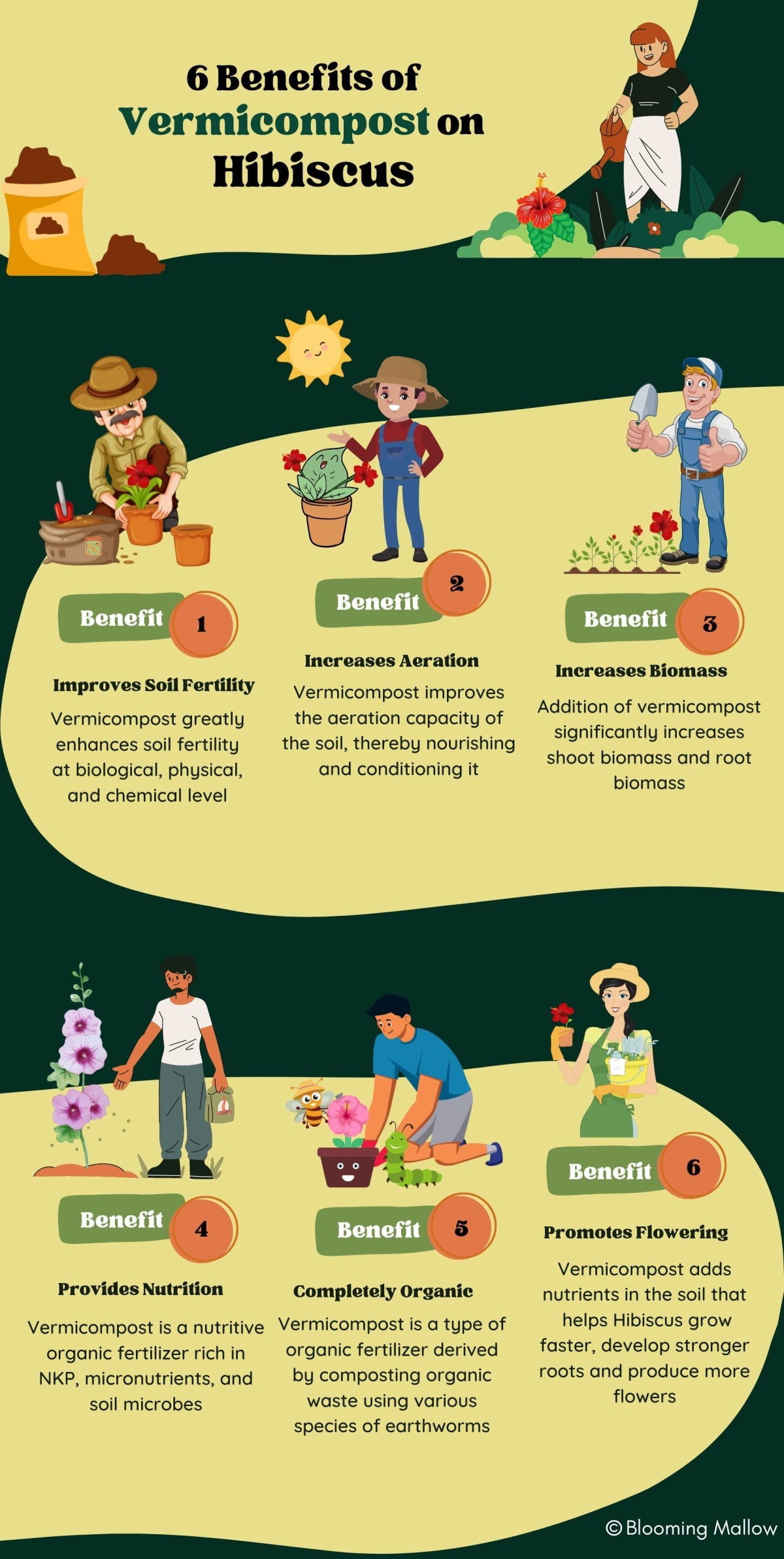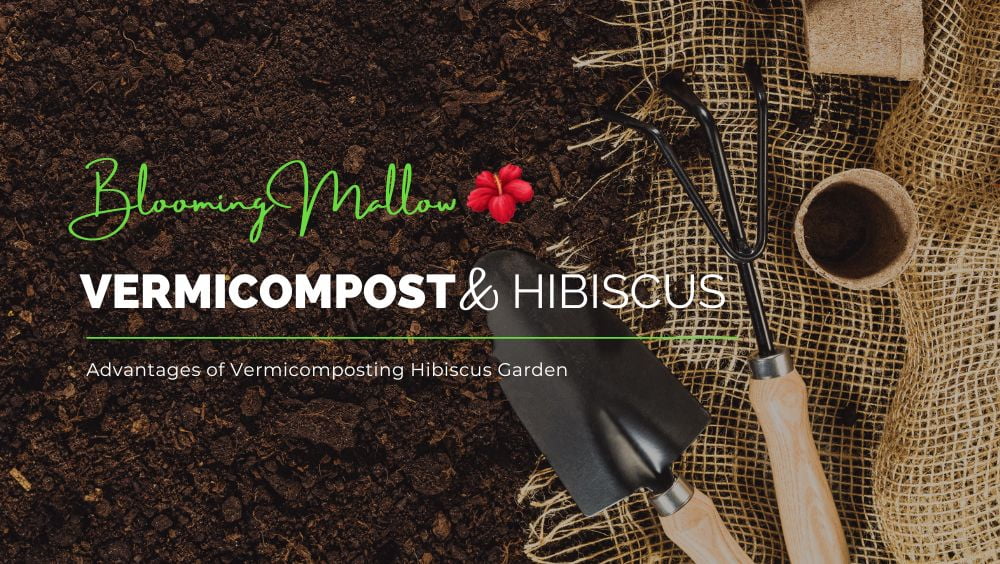
Fertilize your Hibiscus in a classic way with the help of an all-natural and completely organic product. A fertilizer obtained by the slow decomposition of solid waste by worms. And the one that has all the qualities to promote overall growth.
Vermicompost is used in almost all types of organic farming that you have probably heard of, and can also be used for houseplants as well as your gardens. It pairs beautifully with the surrounding soil and gives plants all the love they need.
But if you’re new to growing Hibiscus, you may not be aware of just how effective this natural fertilizer is. That is perhaps the only reason I am writing this so obvious article. So, let’s get started.
What Is Vermicompost?
The term “vermicompost” comes from the Latin word “vermis”, which means worms, and “compost”, which is nothing but decomposed organic waste (twigs, grass, flowers, fruits, and vegetables).
It is prepared by decomposing all these organic wastes in a bin along with earthworms. The compost worms burrow through this waste, digest it, break it down, and turn it into worm castings.
These worms are then carefully separated, and the digested compost is packaged and marketed as vermicompost.
Vermicompost contains an active organic mixture of bacteria, enzymes, plant residues, animal waste, and worm eggs. It is rich in minerals such as nitrogen, phosphorus, magnesium, potassium, and calcium. And contains micronutrients such as manganese, copper, zinc, cobalt, borax, iron, and carbon. And despite so many nutrients, there is absolutely no risk of overfertilization.
How Is Vermicompost Good For Soil?
By using vermicompost, not only do you provide the soil with essential nutrients but also help it regain its chemical properties that are normally lost over time. In addition, vermicompost improves the physical properties of the soil, making it softer and lighter.
It is also beneficial in stimulating the vitality of the soil, by activating microorganisms associated with the plant’s root system (mycorrhizal symbiosis). The humus produced in turn nourishes soil life, creating the conditions for healthy and fertile soil.
This is a very important characteristic from the gardener’s point of view: well-structured soil facilitates the subsurface development of plants, resulting in deeper and much stronger roots. Plus, it makes various soil amendment tasks like digging, weeding, etc. less strenuous.
Another very interesting feature is that the humus generated from vermicompost is completely odorless: it does not smell like other organic fertilizers such as poultry or cow manure. For this reason, vermicompost is particularly suitable for balcony planters where it is difficult to use products that generate unpleasant odors.
On top of that, vermicompost possesses a high-water retention capacity, which helps the soil retain moisture for a long time. So, if you have a habit of underwatering, vermicompost will be quite beneficial here to help plants retain much-needed moisture.
Can You Add Vermicompost To Hibiscus Plant?
Once the vermicompost decomposes in the soil, it is transformed into humus, which is an excellent fertilizer for any type of soil. This humus contains all the nutrients necessary for the growth process of plants.
So, adding vermicompost, therefore, means enriching your garden or potted Hibiscus plant with nutrients necessary for its overall well-being. More importantly, these nutrients include nitrogen, phosphorus, and potassium (NPK) which are essential for Hibiscus to grow and thrive.
If you use too much inorganic fertilizer, you can burn the plant and even damage it irreparably. The same goes for organic fertilizers such as chicken or pelleted manure. Vermicompost, on the other hand, a processed by-product of worms, does not have this effect and can be used sporadically – making it quite suitable for novice gardeners.
And because of its versatility, it can be used not just for soil amendment but also for transplantation and propagation of Hibiscus.
Benefits Of Adding Vermicompost To Hibiscus Plant

Advantages at the physical level:
- Delivers balanced nutrition, immediately available to the plants
- Has excellent purifying properties that enables it to decontaminate soils with chemicals
- Aerates the soil and improves its absorption capacity
- Improves the germination capacity of seeds
- Reduces soil erosion
- Allows for deeper root penetration into the soil
- Absorbs more of the sun’s rays and allows the soil to warm more quickly
Advantages at the chemical level:
- Facilitates the stabilization of PH levels and improves the health of plants
- Enriches the soil with organic matter and essential minerals
- Provides trace elements along with nutrients
- Transforms nutrients into assimilable form
- Preserves and increases the organic content in the soil
- Protects against foliar diseases
Advantages at the biological level:
- Reduces shock during transplant
- Promotes the formation of mycorrhizal fungi
- Increases the count of essential microbes
- Improves plant resistance against pests
How Much Vermicompost Can I Use On Hibiscus?
You can use vermicompost as a long-term measure to revitalize and restructure the soil. It is therefore an indispensable material for every gardener. However, it should not be used alone! And while there is nothing wrong in doing so, the most ideal way is to mix it up with the potting soil. This will produce a complete mix that is perfect for the health of your hibiscus.
Alternatively, you can rake the topsoil and then add vermicompost so that it mixes well with the plant soil. The different composition of soil and compost makes it possible to enrich your plant and promote overall growth.
Here’s how you can use vermicompost on hibiscus:
- Rake the garden area and spread a handful at the base of each hibiscus
- For pots (indoor and outdoor), remove about 3 inches of the old soil from the surface and replace it with 2 tablespoons of vermicompost
- When transplanting/repotting, mix a handful of vermicompost with the potting soil (1/4 vermicompost, 3/4 soil)
- For amending heavy hibiscus soil, use 1/2 soil + 1/4 vermicompost + 1/4 river sand
- For amending light hibiscus soil, use 2/3 garden soil + 1/3 vermicompost
Note: You can also use vermicompost in the winter, as it is practically a slow-release fertilizer and keeps the hibiscus from going dormant (if you see the plant growing and forming new leaves, you should fertilize it no matter what time of the year it is).
I use vermicompost on a bi-weekly basis in summer and once every month in winter and so far, have had a very good experience with it. So, I wouldn’t worry too much about possible over-fertilization. The best thing to do is observe the plants. If they look healthy and are growing well, then your nurturing techniques are good.
Can I Put Vermicompost Along With Organic Manure In The Hibiscus Plant?
Even though vermicompost and manure are both organic and look almost the same, in reality they are very different, both in terms of the production process and properties. Unlike traditional compost (cow/horse manure), vermicompost is much more ideal because of its higher nitrogen, phosphorus and potassium content, which significantly improves the soil structure and its ability to retain water.
However, it costs more, so it can be quite expensive if used in a large hibiscus garden. For this reason, there is nothing wrong with mixing the two materials to amend the soil, as they are both natural and do not harm the plant in any way, even if used excessively at times. But for best results, it is wise to follow the instructions given here.
While adding both vermicompost and organic manure to Hibiscus, make sure you reduce the quantities to half. For instance, if you were using a handful of vermicompost alone, you would need to use half of the vermicompost and half of the manure while using them together.
Summary
The most common deficiencies, be it a garden or potted Hibiscus, can be easily remedied by adding vermicompost. The good thing about this organic ingredient is that it has the ability to balance the soil: So, on one hand, it lightens heavy clay soils and improves drainage, and on the other, it allows sandy soils to retain water and nutrients better.
Thus, regular addition of vermicompost improves the structure of the soil in the long term, by restoring humus and key microbes. As a result, the soil becomes much looser and more aerated, while its ability to retain water is greatly improved.
If you’re looking for additional ways to support your hibiscus plants, you may want to consider introducing ladybugs to your garden. Ladybugs are a great addition to the hibiscus garden as they play a crucial role in controlling pests, especially aphids, and promoting pollination.
Regardless of your fertilization techniques, you need to maintain an adequate amount of moisture in the soil for optimal absorption. Then again, absorption decreases if the moisture content increases beyond a certain degree. So, it is important to maintain the right balance of water in your soil. Read in detail how often your hibiscus plant needs to be watered so as to ensure that every available mineral in the soil is absorbed by your plant.
This brings us to the end of this article. I hope you enjoyed reading it and gained some valuable information.
Have fun gardening!





